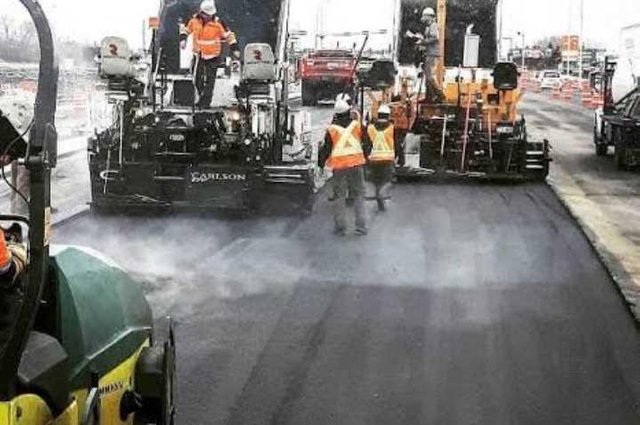Asphalt is a material consisting of a mixture of rocks (coarse aggregates and fine aggregates) with asphalt bonding material having certain requirements, before the two materials are mixed homogeneously, it must be heated first. Because it is mixed in a hot state, it is called a hot mixture. All hot mixed work is done in a plant called "Asphalt Mixing Plant" (AMP).

Road construction consists of several layers, including:
- Subgrade
- Sub Base Course
- Base Course, and
- Surface
Asphalt concrete used for pavement layer also consists of several types, namely:
- The foundation layer
- Tear layer, and
- Second layer
Stability
Asphalt concrete stability is intended for sidewalks that support the traffic load without changing the shape. The stability of the mixture is obtained from friction, between internal friction particles, interlocking forces, and good adhesion forces between the stone and the asphalt. These forces are influenced by hardness of the rock surface, gradation size, granular shape, bitumen content, and mixed density.
Durability
Concrete asphalt is intended for weather-hardened pavement and workload traffic. Factors that support endurance include, high levels of asphalt, solid gradation, and perfect density.
Flexibility
The asphalt flexibility of concrete is meant for the sidewalk and overcome the deflection, as the traffic load repeats without changing the shape. The flexibility of the sidewalks can be achieved by using relatively open gradations and adding certain asphalt content, thereby increasing resistance to loading.
Asphalt
- Asphalt is an oil-based product derived from
the process of refining petroleum, and known as hard asphalt. - Asphalt is also present in nature naturally, this asphalt is a natural asphalt.
- The asphalt is made by adding additional materials to the asphalt, aiming to refine or modify its rheological safari, thus producing a new type of asphalt called asphalt modification.

Asphalt of Distillation
Crude oil is distilled, a process of various fractions separated from crude oil. This distillation process is accompanied by an increase in the temperature of the crude oil heating. At a certain temperature from the distillation process will be produced oil-based products.
Asphalt Hard: In the distillation process the mild fraction contained in oil is separated by a simple distillation to leave a residue known as hard asphalt. In this distillation process, the new hard asphalt is produced by a vacuum distillation process at a temperature of about 480ºC. This temperature varies depending on the source of crushed crude oil or the level of hard asphalt to be produced.
To produce hard asphalt with desirable properties, the distillation process must be handled in such a way that it can control the hard asphalt properties produced. This is often done by mixing various variations of crude oil before the distillation process is carried out. This mixing will produce hard asphalt with varying properties, according to the desired properties. Another common way to get hard asphalt is with medium viscosity, mixing different types of hard asphalt with a certain proportion where very hard, hard asphalt is mixed with other aqueous asphalt to produce medium viscosity. In addition to the vacuum distillation process, asphalt is produced from heated crude oil and dust, hard asphalt can also be produced by solvent extraction process. In this process the oil fraction (gasoline, diesel, and kerosene) contained in crude oil, is removed so as to leave asphalt as residue.
Liquid asphalt: Liquid asphalt is produced by dissolving hard asphalt with an oil-based solvent. This asphalt can also be produced directly from the distillation process, in this process, the light oil contained in the crude oil is not completely disposed of. Steam evaporating oils used as solvents, or oils which are intentionally left behind in the residue in the distillation process will determine the type of liquid asphalt produced. Liquid asphalt is distinguished in several types, namely:
Rapid Asphalt Liquid (RC = Rapid Curing), which is a liquid asphalt, the solvent evaporates rapidly. The solvents used in this type of asphalt are usually gasoline.
Medium Medium Curing Asphalt (MC = Medium Curing), which is a liquid asphalt, the solvent does not evaporate so quickly. The solvents used in this type of asphalt are usually kerosene.
Asphalt Liquid Landing (SC = Slow Curing), which is a liquid asphalt, slow solvent evaporates. The solvents used in this type of asphalt are diesel.
The level of liquid asphalt viscosity is determined by the proportion or ratio of solvents used for hard asphalt or contained in liquid asphalt. Asphalt type MC-800 has a higher viscosity value than MC-200.
Asphalt Emulsion: Asphalt emulsion is produced by using hard asphalt hardening process. In this process, hard asphalt particles are separated and dispersed in water containing emulsifiers. These dispersed asphalt particles are very small, even most of them very small, even most of them are colloids. The type of emulsifer used greatly affects the type and speed of binding of emulsion asphalt produced. Based on the electrical charge of the emulsifier used, Asphalt emulsion can be divided into:
- Asphalt emulsion, is a negative ionized emulsion asphalt.
• Cationic emulsion asphalt, is a positively ionized emulsion bit.
· Non-ionic asphalt, asphalt emulsion asphalt / neutral.
Natural Asphalt: Natural asphalt is an asphalt that naturally occurs in nature. Based on natural asphalt deposits grouped into 2 groups, namely:
· Asphalt Lake
This asphalt is naturally present in lakes in Trinidad, Venezuella and lewele. This asphalt consists of asphalt, minerals, and other organic materials. Asphalt penetration rate is very low and essentially soft is very high. Because it mixes with hard asphalt and has a high penetration rate with a certain ratio, so that the asphalt is produced with the desired penetration rate.
- Asphalt Stone
Asphalt Kentucky stone and buton is a natural asphalt stored in Kentucky, USA. Asphalt of this precipitate is formed in the limestone slit of sandstone. The asphalt contained in this stone ranges from 12 to 35% of the stone period and has a percentage between 0 - 40. For use, this deposit must be weighed first, then the asphalt is extracted and mixed with softening oil or bitumen difficult with the desired penetration rate . When these asphalt stones have been developed further, resulting in asphalt stones in the form of grains, particles smaller than 1 mm in size and in the form of resin.
- Asphalt Modification
Asphalt modifications are made by mixing hard asphalt with additional material. Polymers hazardous type of additive materials are often used today, so asphalt modification is often called asphalt polymer. Among other things, by its nature, there are two types of polymeric materials usually used for this purpose, namely:
Asphalt Polymer Elastomers and rubber are a type of polyether elastomer:
a. SBS (Styrene Butadine Sterene)
b. SBR (Styrene Butadine Rubber)
c. SIS (Styrene Isoprene Styrene), and
d. Rubber type hazard polymer elastoner which is usually used as a hard asphalt agitator.
The addition of this type of polymer is intended to enhance the asphaltic rheological properties, including penetration, viscosity, softening point and hard asphalt elasticity. A paved mixture prepared with polymeric asphalt elastomers will have a higher elasticity level than asphalt mixtures made with hard asphalt. The percentage of additive additives on polymer asphalt production should be determined on the basis of laboratory testing, since the addition of additives to some extent can indeed improve the rheological properties and asphalt mixtures, but excessive addition will have a negative effect.
- Asphalt Polymer Plastomers
As with polymeric elastomeric asphalt, the addition of polymeric plastomers to hard asphalt materials is also intended to improve the rheological properties of hard asphalt and purity properties of asphalt mixtures. Type of polymer plastomers that have been widely used include EVA (Ethylene Vinyle Acetate), Polypropilene, and Polyethilene. The percentage of addition of this polymer into hard asphalt should also be determined on the basis of laboratory testing, since the addition of additional ingredients to some extent this addition can improve the nature of rheology and asphalt mixtures but excessive addition will have a negative effect.
- Asphalt Classification
Hard asphalt can be classified into classes
based on three different systems:
a. Viscosity: viscosity after aging and penetration. Each system classifies asphalt in different levels or classes. In the existing asphalt classification, the most widely used is the classification system based on viscosity and penetration. In the viscosity system, the poise unit is the approximate absolute viscosity. The higher the poise value of asphalt statu the thicker the asphalt.
AC-25 (hard asphalt with 2550 viscosity pose at 60 ° C) is soft hard asphalt type, AC-40 (hard ash with 400 poise at 60ºC) is hard, hard asphalt type. Some countries classify asphalt based on the viscosity of estuary aging. This idea is to identify the viscosity of estella exploitation asphalt in the field. To simulate the aging of the asphalt during mixing, the fresh asphalt to be used is poured first in the oven by testing the Thin Film Oven Test (TFOT) and Rolling Film Oven Test (RTFOT). The rest of the asphalt (residue) is then determined by the fossil in poise.
b. Penetration Test: standard needle with 10 gram load (including needle weighing) penetrated on asphalt surface, needle length entering asphalt sample within five seconds measured in tenth unit of 0.1 mm, and expressed as bitumen penetration value. The smaller the penetration value of asphalt, the harder the asphalt.
- Asphalt Chemical Properties
Hard asphalt is produced through petroleum distillation process. The petroleum used naturally is made up of thousands of years old organic compounds under pressure and high temperature variations. The arrangement of the internal structure of the asphalt is largely determined by the chemical arrangement of the molecules contained in the asphalt. The arrangement of asphalt molecules is very complex and dominates 90 to 95% by weight of asphalt, by elements of carbon and hydrogen. Therefore, asphalt compounds are often referred to as hydrocarbon compounds. A small portion, the remaining 5 to 10%, of two types of atoms, namely: heteroatoms and metals.
Heteroatomic elements such as Nitrogen, Oxygen and Sulfur. It can replace the position of carbon atoms present in the structure of the asphalt molecule. This is why asphalt has a unique chemical chain and interaction between atoms, this atom can cause changes in the physical properties of asphalt. The type and amount of heteroatomes contained in the asphalt is determined by the source of the crude used and the aging rate. Heteroatoms, especially sulfur, are more reactive than carbon and hydrogen to bind oxygen. Therefore, the asphalt of high sulfur content will age faster than sulfur-containing asphalt. Metal atoms such as vanadium, nickel, iron, magnesium and calcium are contained only in asphalt in very small quantities, generally asphalt containing only one percent of metal atoms in the form of organic salts and hydroxides.
Due to the complex chemical arrangement of asphalt, asphalt chemical analysis is very difficult and requires sophisticated laboratory equipment, and the resulting data may not necessarily be related to asphaltic rheological properties. The resulting chemical analysis can usually only separate the asphaltic molecules in two groups, namely aspalten and malten. Furthermore, malten can be divided into saturated, aromatic and resin. However, this division can not be clearly defined because of the overlap between the groups.

Physical Properties of Asphalt
Asphalt properties greatly affect planning, production and performance. The paved mix includes:
A. Endurance
Asphalt performance is strongly influenced by the asphalt properties after being used as a binder in asphalt mixture and spreading in the field. This is because the properties will change significantly, because oxidation and peeling occur during mixing, installation and mixing of asphalt mixtures in the field. A change of this nature will occur and cause the asphalt to become low-powered, or in other words, the asphalt has undergone penuan. Asphalt's ability to block the aging rate is called bitumen endurance.
Testing aims to know how well asphalt to retain its original properties due to the aging process. Although many other factors are decisive, the asphalt with durability will both produce a mixture with good performance as well. Quantitative tests are usually performed to determine the durability of asphalt is a penetration test, softening point, weight loss and ductility. This test is done on test objects that have undergone Presure Aging Vassel (PAV), Thin Film Tests Oven (TFOT) and Test Rolling Thin Film Oven (RTFOT). These two processes of aging are the most widely used aging process to know asphalt durability. The properties of asphalt especially viscosity and penetration will change if the asphalt heats or ages. Asphalt with good endurance will change.
B. Adhesion And Cohesion
Adhesion is the ability of bitumen particles to stick to each other, and cohesion is the ability of the asphalt to stick and bind the aggregate. The properties of adhesion and cohesion are very important in the manufacture of asphalt mixtures. Because these properties affect the performance and durability of the mixture. Asphalt ductility test is a qualitative test that indirectly can be done to know the level of adesifnes or hardness of bitumen channel. Asphalt hard with a low ductility value being an asphalt that has less adhesive strength than an asphalt having a high ductility value. Seal testing of rock asphalt is another quantitative test used to determine stickiness (cohesion) from asphalt to stone.
In this test, the aggregate that has been covered by the asphalt film is immersed in water and left for 24 hours without stirring. Due to the combination of water with certain mechanical strength, the aggregate surface asphalt cover will peel back. Asphalt with a strong cohesion style will be firmly attached to the aggregate surface, then peeling occurs as a result of the influence of water or a combination of water with very little mechanical strength or even not happen at all.
C. Asphalt Sensitivity To Temperature
All asphalt is a thermoplastic that becomes louder when the temperature decreases and softens as the temperature rises. The sensitivity of the asphalt to change the property due to changes in the temperture is known as the bitumen sensitivity to temperature.
D. Hardening And Aging Of Asphalt
Aging of asphalt is a good parameter to know the durability of the asphalt mixture. Aging is caused by two main factors: evaporation of oil fractions contained in asphalt and oxidation of short-term and progressive oxidation aging or long-term aging. Oxidation is the most important factor that determines the speed of aging.
Conclusion
Asphalt is used to patch the thickness of the foundation construction and to update the surface. Consists of a layer of rock with granules that lie larger on the road surface, with a thickness of about 1.5 x the size of the largest rock, then compacted into a compact and stable, then dipenetrasi to bind to each other.



About The Science I Have Written:
Science: | Science: | Science: | Science: | Science: | Science: | Science: | Science: | Science: | Science: | Science: | Science: | Science: | Science: | Science: | Science: | Science: | Science: | Science: |